Reliable Data Collection Methodology for Face Recognition in Preschool Children
Abstract
:1. Introduction
2. Related Work
| Category | Dataset | Age Group | Availability | Consent | The Number of Subjects | The Number of Images |
|---|---|---|---|---|---|---|
| 1 | MORPH [9] | 16–77 | Public | o | 70,000 | 402,055 |
| MORPH (Academic) [9] | 16–77 | Public | o | 13,618 | 55,134 | |
| FG-NET [10] | 0–69 | Public | o | 82 | 1002 | |
| 2 | PCSO [11,12] | 18–83 | Private | x | 18,007 | 147,784 |
| MSP [11] | 18–78 | Private | x | 9572 | 82,450 | |
| 3 | CLF [13] | 2–8 | Private | Parental agree | 919 | 3682 |
| NITL [14] | 0–4 | Private | Parental agree | 314 | 3144 | |
| Newborns [15] | Newborn | Private | Parental agree | 450 | 1200 | |
| 4 | CMBD [16] | 2–4 | Public | Parental agree | 106 | 1060 |
| 5 | CACD [17] | 16–62 | Public | A tacit agreement | 2000 | 160,000 |
| ITWCC [18] | 5–32 months | Public | A tacit agreement | 304 | 7990 | |
| 6 | Ours | 2–7 | Private | Parental agree | 78 | Video 35:59 |
3. Database
3.1. Data Collection Considering the Age of the Subject
3.2. Our Data Collection Method & Database Structure
4. Appropriate Camera Positioning for Daycare Center
4.1. Camera Installation Location for Daycare Center: Outdoor
4.2. Camera Installation Location for Daycare Center: Indoors
5. Experiment
5.1. Pre-Experiment for DB Performance Test
- The camera should be installed at a location such that it does not impede the movement of children.
- There should be few external elements that cover the children’s faces.
- Cameras should be installed where children’s movements are simple.
- Cameras should be installed in spaces that are not too crowded.
- The distance between the children and the camera should not be too close or too far (within about 1.5 m).
- A place where there is little involvement of teachers or guardians is preferable.
- There should be little risk of camera repositioning or breakage.
- The illuminance should be constant.
- There should not be any visible buttons on the screen when the camera is running.
- The physical buttons should not work when the camera is running.
- The camera can only be terminated through a ‘hidden button’ (e.g., touch a certain position of the screen five times, etc.).
5.2. Algorithm
- Operating system: Windows 10;
- CPU: Intel(R) Core(TM) i7-8700K;
- RAM: 32GB;
- GPU: NVIDIA Titan RTX;
- Programming language: Python 3.6;
- Machine learning library: PyTorch 1.8.1.
- Face detection: Retinaface;
- Feature extraction: MobileFaceNet + ArcFace;
- Classification: k-nearest neighbor (kNN).
5.3. Child Face Recognition Rate
6. Conclusions
Author Contributions
Funding
Institutional Review Board Statement
Informed Consent Statement
Data Availability Statement
Conflicts of Interest
References
- Gligorijević, J. Children’s privacy: The role of parental control and consent. Hum. Rights Law Rev. 2019, 19, 201–229. [Google Scholar] [CrossRef] [Green Version]
- Srinivas, N.; Ricanek, K.; Michalski, D.; Bolme, D.S.; King, M. Face recognition algorithm bias: Performance differences on images of children and adults. In Proceedings of the IEEE Conference on Computer Vision and Pattern Recognition Workshops (CVPRW), Long Beach, CA, USA, 15–20 June 2019. [Google Scholar]
- Elharrouss, O.; Almaadeed, N.; Al-Maadeed, S. LFR face dataset: Left-Front-Right dataset for pose-invariant face recognition in the wild. In Proceedings of the 2020 IEEE International Conference on Informatics, IoT, and Enabling Technologies (ICIoT), Doha, Qatar, 2–5 February 2020; pp. 124–130. [Google Scholar]
- Wang, Z.; Wang, G.; Huang, B.; Xiong, Z.; Hong, Q.; Wu, H.; Yi, P.; Jiang, K.; Wang, N.; Pei, Y.; et al. Masked face recognition dataset and application. arXiv 2020, arXiv:2003.09093. [Google Scholar]
- Huang, B.; Wang, Z.; Wang, G.; Jiang, K.; He, Z.; Zou, H.; Zou, Q. Masked face recognition datasets and validation. In Proceedings of the Proceedings of the IEEE/CVF International Conference on Computer Vision, Montreal, BC, Canada, 11–17 October 2021; pp. 1487–1491. [Google Scholar]
- Huang, G.B.; Mattar, M.; Berg, T.; Learned-Miller, E. Labeled faces in the wild: A database for Studying face recognition in unconstrained environments. In Proceedings of the Workshop on Faces in ‘Real-Life’ Images: Detection, Alignment, and Recognition, Marseille, France, 14 May 2008. [Google Scholar]
- Sengupta, S.; Chen, J.C.; Castillo, C.; Patel, V.M.; Chellappa, R.; Jacobs, D.W. Frontal to profile face verification in the wild. In Proceedings of the IEEE Winter Conf. Applications of Computer Vision (WACV), Lake Placid, NY, USA, 7–10 March 2016; pp. 1–9. [Google Scholar]
- Yi, D.; Lei, Z.; Liao, S.; Li, S.Z. Learning face representation from scratch. arXiv 2014, arXiv:1411.7923. [Google Scholar]
- Ricanek, K.; Tesafaye, T. Morph: A longitudinal image database of normal adult age-progression. In Proceedings of the 7th Int’l Conference on Automatic Face and Gesture Recognition (FG06), Southampton, UK, 10–12 April 2006; pp. 341–345. [Google Scholar]
- FG-NET (Face and Gesture Recognition Network) Ageing Database. 2014. Available online: https://yanweifu.github.io/FG_NET_data/ (accessed on 16 February 2021).
- Deb, D.; Best-Rowden, L.; Jain, A.K. Face recognition performance under aging. In Proceedings of the IEEE Conference on Computer Vision and Pattern Recognition Workshops (CVPRW), Honolulu, HI, USA, 21–26 July 2017; pp. 46–54. [Google Scholar]
- Best-Rowden, L.; Jain, A.K. Longitudinal study of automatic face recognition. IEEE Trans. Pattern Anal. Mach. Intell. 2017, 40, 148–162. [Google Scholar] [CrossRef] [PubMed]
- Deb, D.; Nain, N.; Jain, A.K. Longitudinal study of child face recognition. In Proceedings of the International Conference on Biometrics, Gold Coast, Australia, 20–23 February 2018; pp. 225–232. [Google Scholar]
- Best-Rowden, L.; Hoole, Y.; Jain, A. Automatic face recognition of newborns, infants, and toddlers: A longitudinal evaluation. In Proceedings of the 2016 International Conference of the Biometrics Special Interest Group (BIOSIG), Darmstadt, Germany, 21–23 September 2016; pp. 1–8. [Google Scholar]
- Bharadwaj, S.; Bhatt, H.S.; Vatsa, M.; Singh, R. Domain specific learning for newborn face recognition. IEEE Trans. Inf. Forensics Secur. 2016, 11, 1630–1641. [Google Scholar] [CrossRef]
- Basak, P.; De, S.; Agarwal, M.; Malhotra, A.; Vatsa, M.; Singh, R. Multimodal biometric recognition for toddlers and pre-school children. In Proceedings of the IEEE International Joint Conference on Biometrics (IJCB), Denver, CO, USA, 1–4 October 2017; pp. 627–633. [Google Scholar]
- Chen, B.C.; Chen, C.S.; Hsu, W.H. Face recognition and retrieval using cross-age reference coding with cross-age celebrity dataset. IEEE Trans. Multimed. 2015, 17, 804–815. [Google Scholar] [CrossRef]
- Ricanek, K.; Bhardwaj, S.; Sodomsky, M. A review of face recognition against longitudinal child faces. In Proceedings of the International Conference of the Biometrics Special Interest Group (BIOSIG), Darmstadt, Germany, 9–11 September 2015. [Google Scholar]
- Kumar, N.; Belhumeur, P.; Nayar, S. Facetracer: A search engine for large collections of images with faces. In Proceedings of the European Conference on Computer Vision (ECCV), Marseille, France, 12–18 October 2008; pp. 340–353. [Google Scholar]
- Otto, C.; Han, H.; Jain, A. How does aging affect facial components? In Proceedings of the European Conference on Computer Vision (ECCV), Florence, Italy, 7–13 October 2012; pp. 189–198. [Google Scholar]
- Klare, B.; Jain, A.K. Face recognition across time lapse: On learning feature subspaces. In Proceedings of the 2011 International Joint Conference on Biometrics (IJCB), Washington, DC, USA, 11–13 October 2011; pp. 1–8. [Google Scholar]
- Ramanathan, N.; Chellappa, R. Face verification across age progression. IEEE Trans. Image Process. 2006, 15, 3349–3361. [Google Scholar] [CrossRef] [PubMed]
- Grother, P.; Ngan, M. Face Recognition Vendor Test (FRVT) Performance of Face Identification Algorithms; NIST Interagency Report 8009; National Institute of Standards and Technology: Gaithersburg, MD, USA, 2013; pp. 1–138. [Google Scholar]
- Bruce, B.; Thernlund, G.; Nettelbladt, U. ADHD and language impairment. Eur. Child Adolesc. Psychiatry 2006, 15, 52–60. [Google Scholar] [CrossRef] [PubMed]
- Lonigan, C.J.; Bloomfield, B.G.; Anthony, J.L.; Bacon, K.D.; Phillips, B.M.; Samwel, C.S. Relations Among Emergent Literacy Skills, Behavior Problems, and Social Competence in Preschool Children From Low- and Middle-Income Backgrounds. Top. Early Child. Spec. Educ. 1999, 19, 40–53. [Google Scholar] [CrossRef]
- Willcutt, E.G.; Betjemann, R.S.; Wadsworth, S.J.; Samuelsson, S.; Corley, R.; DeFries, J.C.; Byrne, B.; Pennington, B.F.; Olson, R.K. Preschool twin study of the relation between attention-deficit/hyperactivity disorder and prereading skills. Read. Writ. 2007, 20, 103–125. [Google Scholar] [CrossRef]
- Kagan, J. The concept of behavioral inhibition to the unfamiliar. In Perspectives on Behavioral Inhibition; University of Chicago Press: Chicago, IL, USA, 1989. [Google Scholar]
- Blackman, J.A.; Westervelt, V.D.; Stevenson, R.; Welch, A. Management of preschool children with attention deficit-hyperactivity disorder. Top. Early Child. Spec. Educ. 1991, 11, 91–104. [Google Scholar] [CrossRef]
- Barrett, L.F.; Lindquist, K.A.; Gendron, M. Language as context for the perception of emotion. Trends Cogn. Sci. 2007, 11, 327–332. [Google Scholar] [CrossRef] [PubMed] [Green Version]
- Deng, J.; Guo, J.; Xue, N.; Zafeiriou, S. Arcface: Additive angular margin loss for deep face recognition. In Proceedings of the IEEE/CVF Conference on Computer Vision and Pattern Recognition (CVPR), Long Beach, CA, USA, 15–20 June 2019; pp. 4690–4699. [Google Scholar]
- Deng, J.; Guo, J.; Ververas, E.; Kotsia, I.; Zafeiriou, S. RetinaFace: Single-Shot Multi-Level Face Localisation in the Wild. In Proceedings of the IEEE/CVF Conference on Computer Vision and Pattern Recognition (CVPR), Virtual Conference, 14–19 June 2020; pp. 5203–5212. [Google Scholar]
- Zhang, K.; Zhang, Z.; Li, Z.; Qiao, Y. Joint face detection and alignment using multitask cascaded convolutional networks. IEEE Signal Process. Lett. 2016, 23, 1499–1503. [Google Scholar] [CrossRef] [Green Version]
- Chen, S.; Liu, Y.; Gao, X.; Han, Z. Mobilefacenets: Efficient cnns for accurate real-time face verification on mobile devices. In Proceedings of the Chinese Conference Biometric Recognition, Urumchi, China, 11–12 August 2018; pp. 428–438. [Google Scholar]
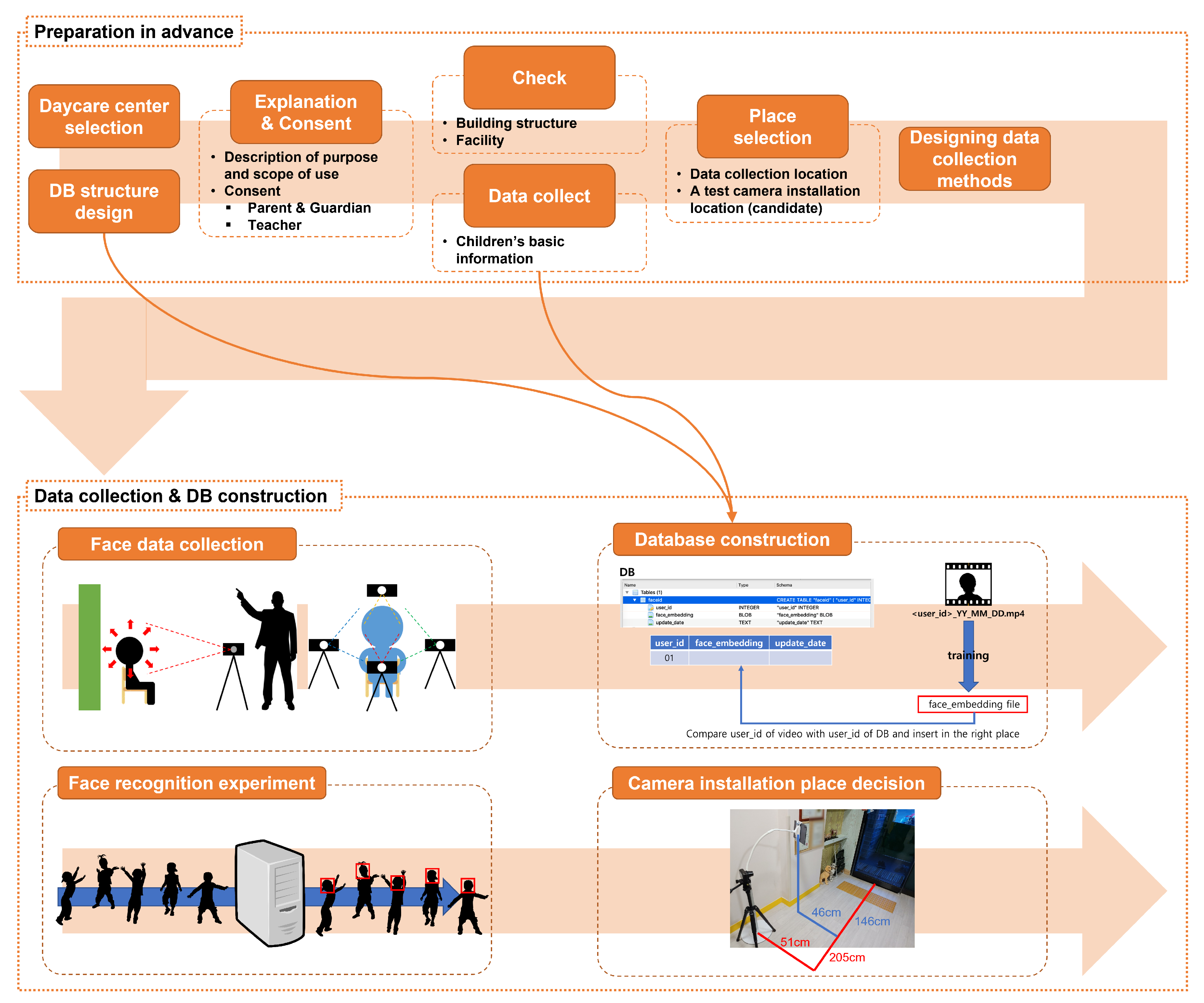
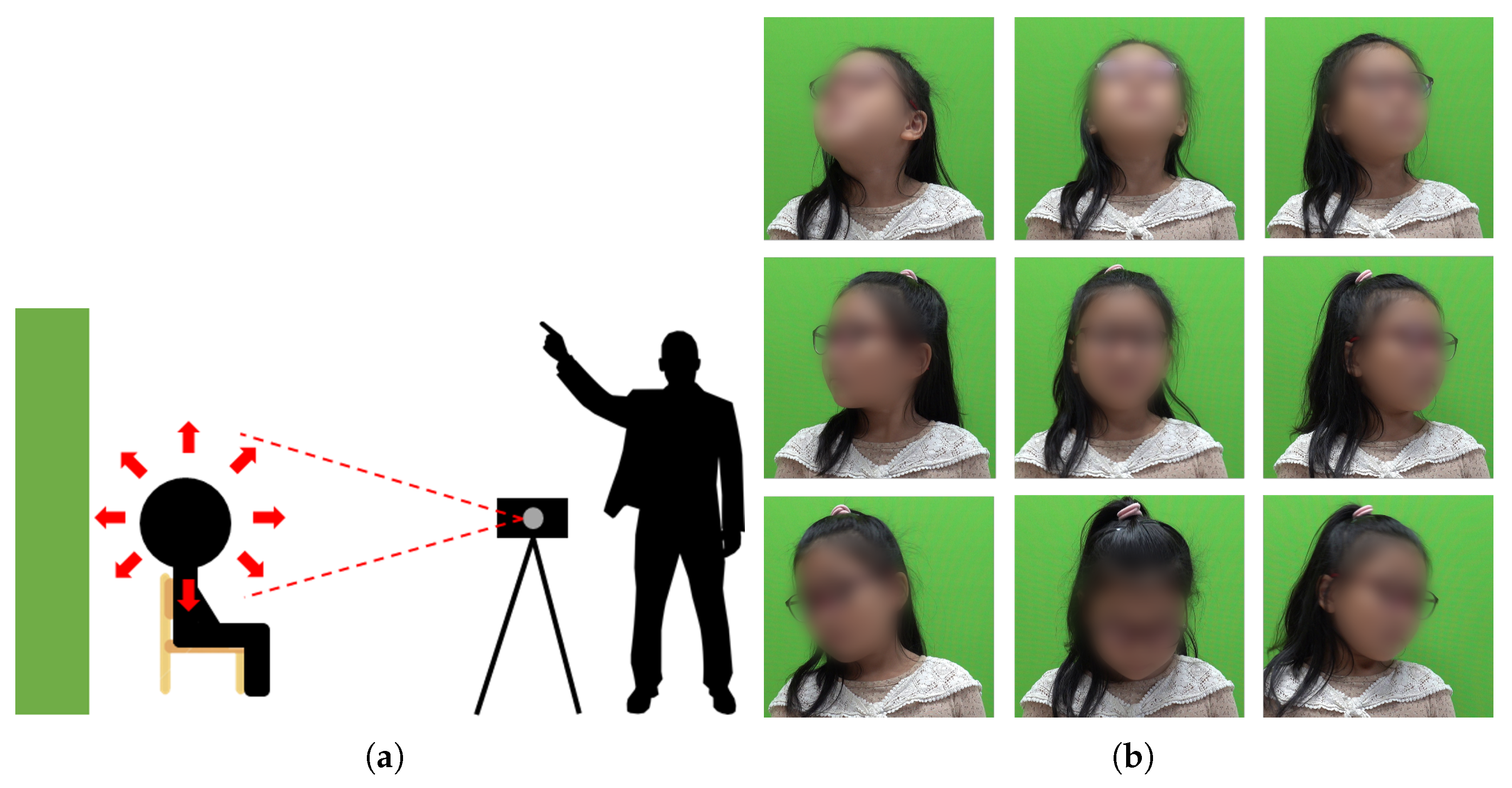
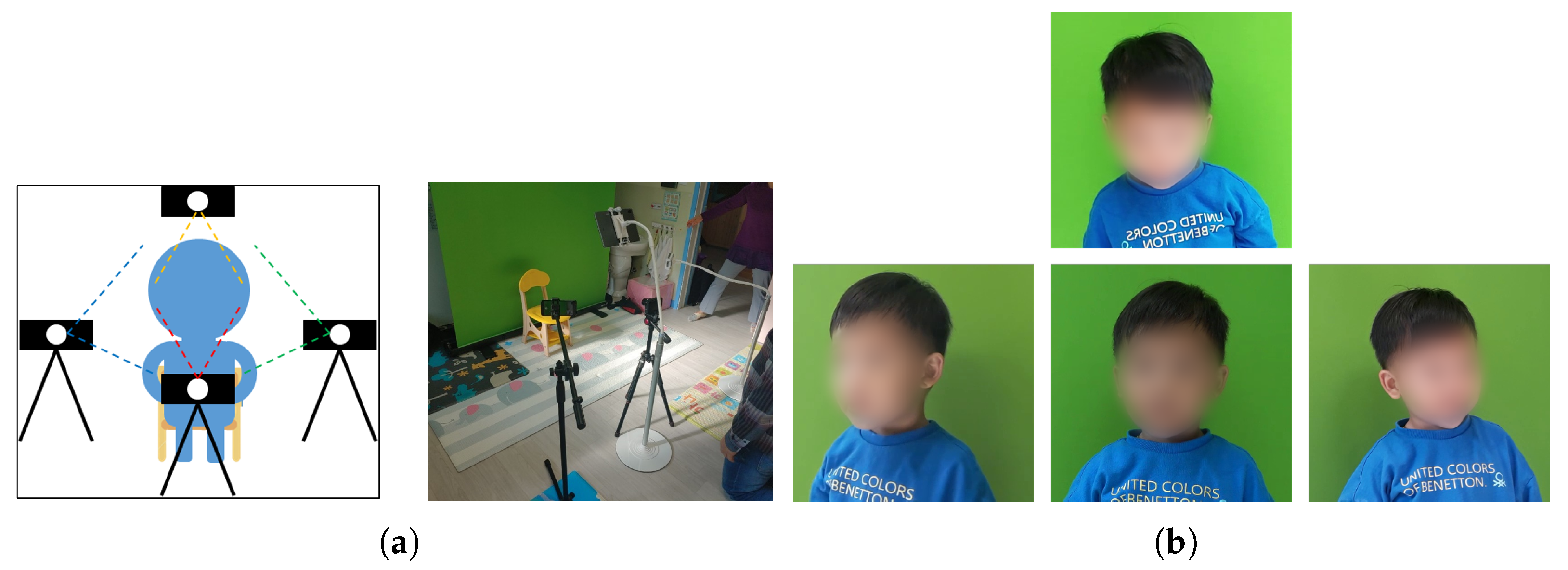
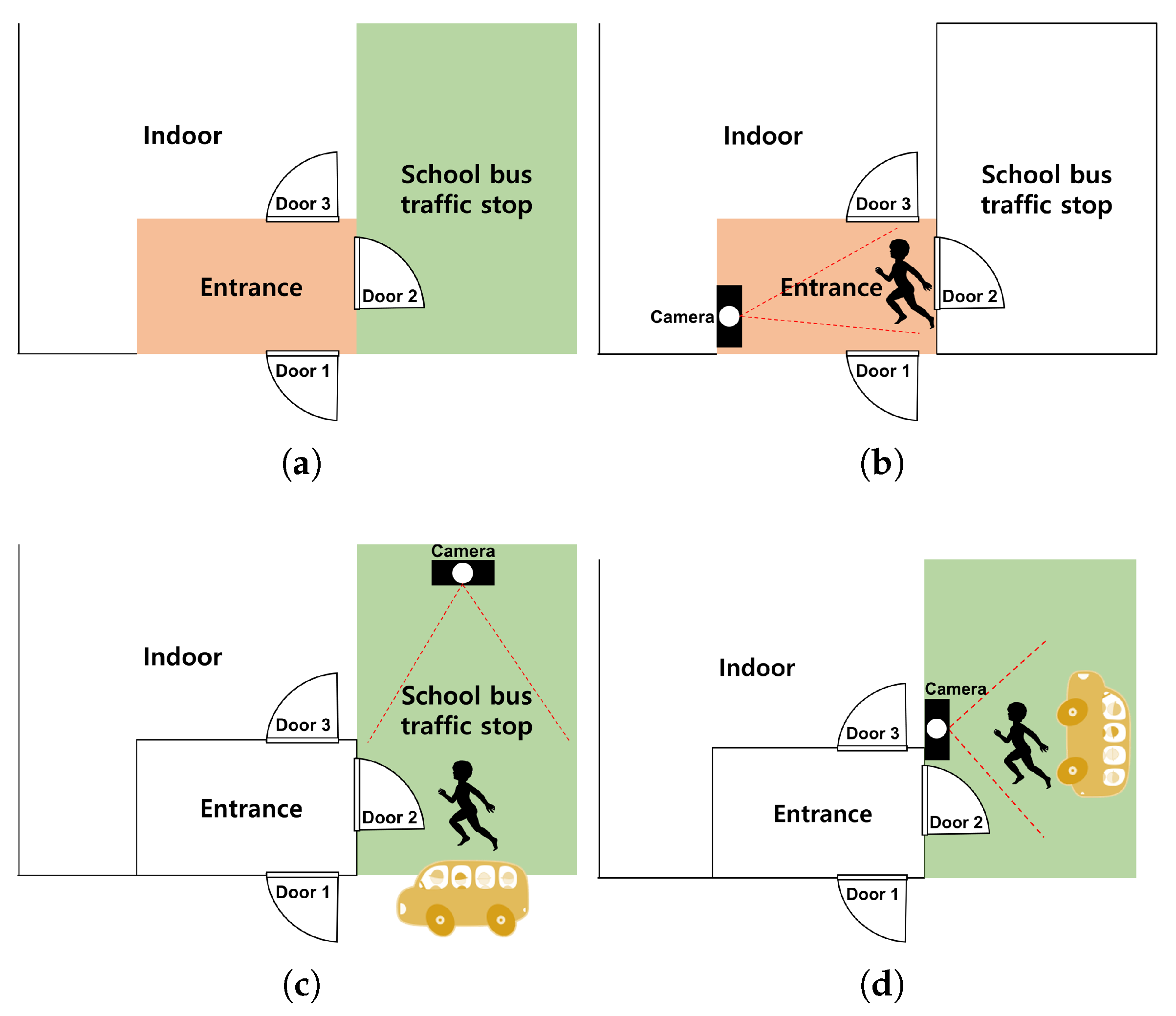
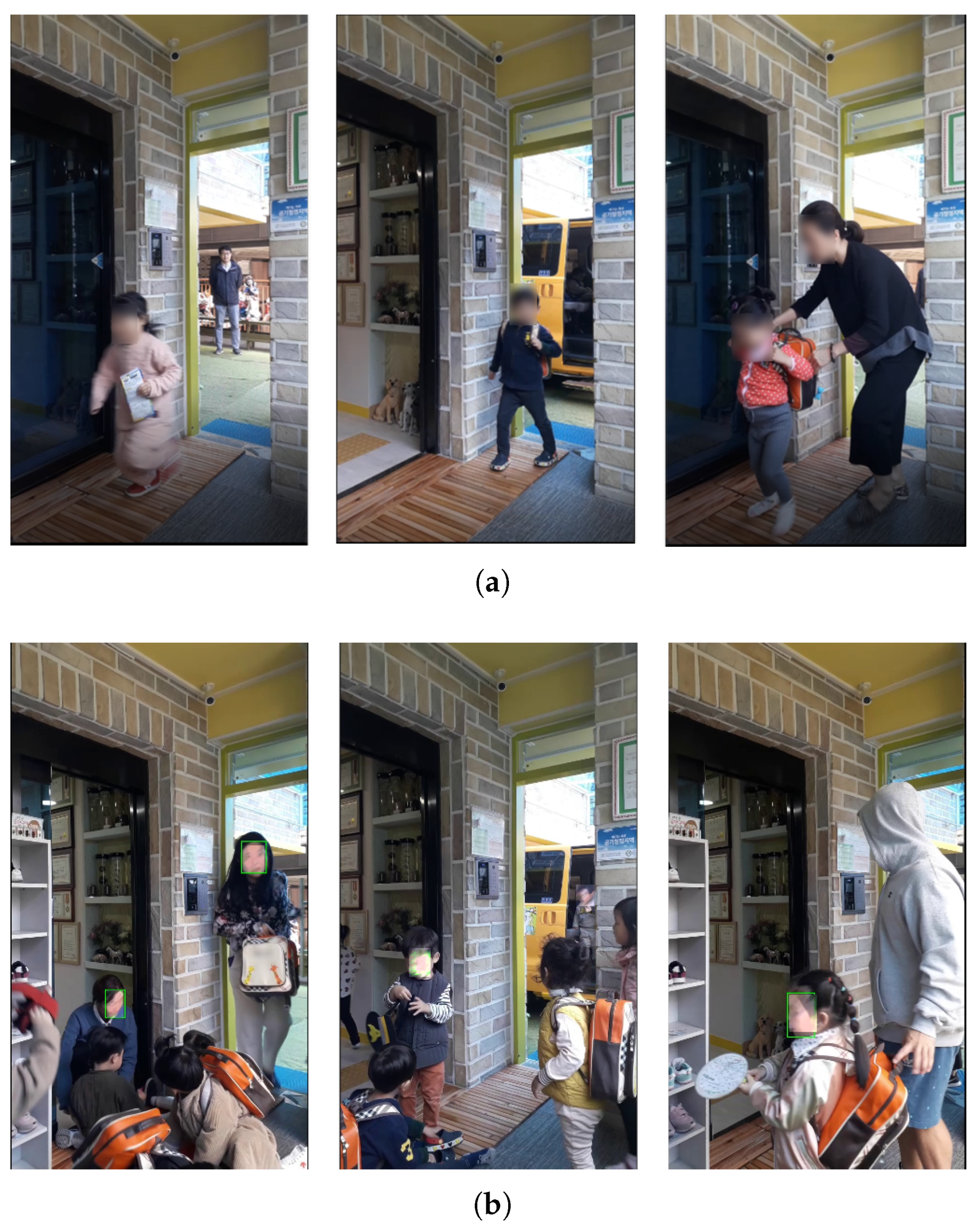


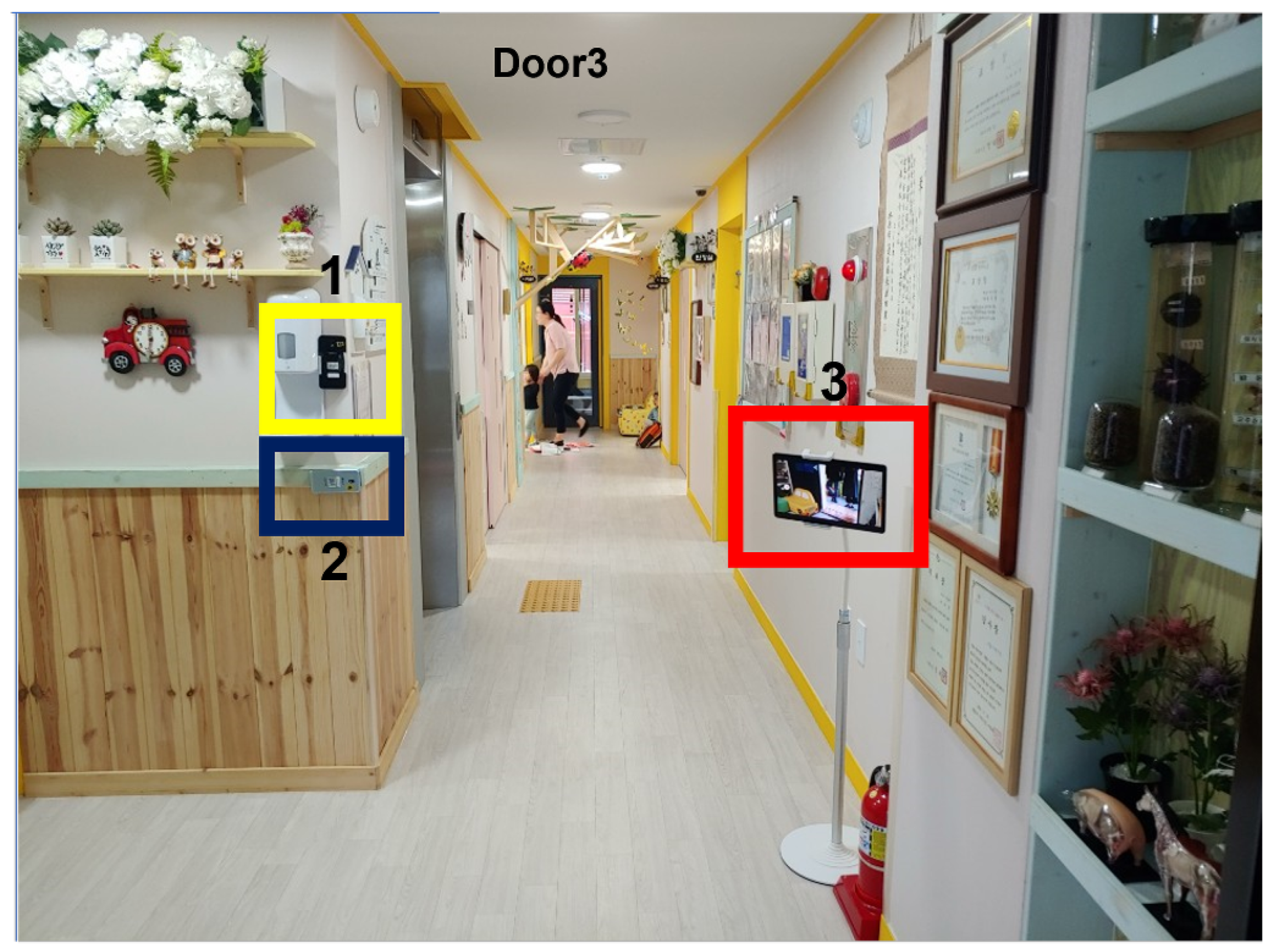
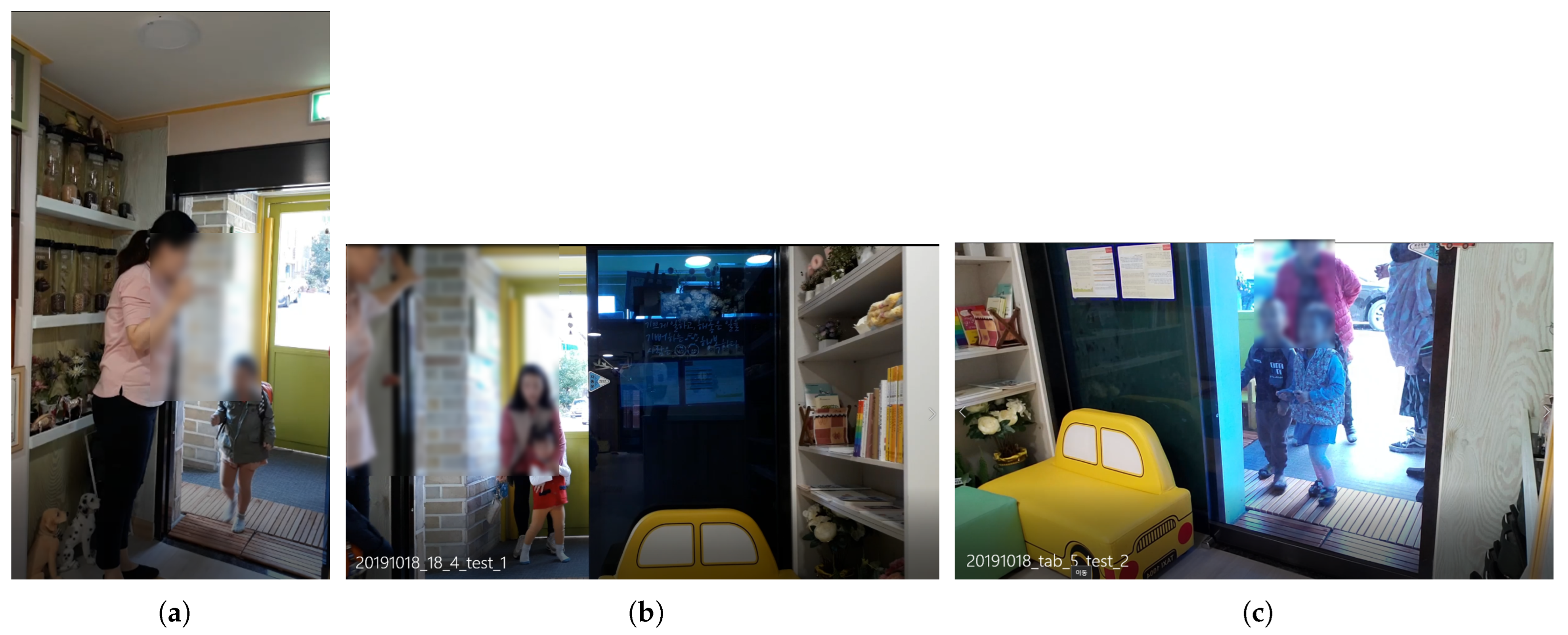
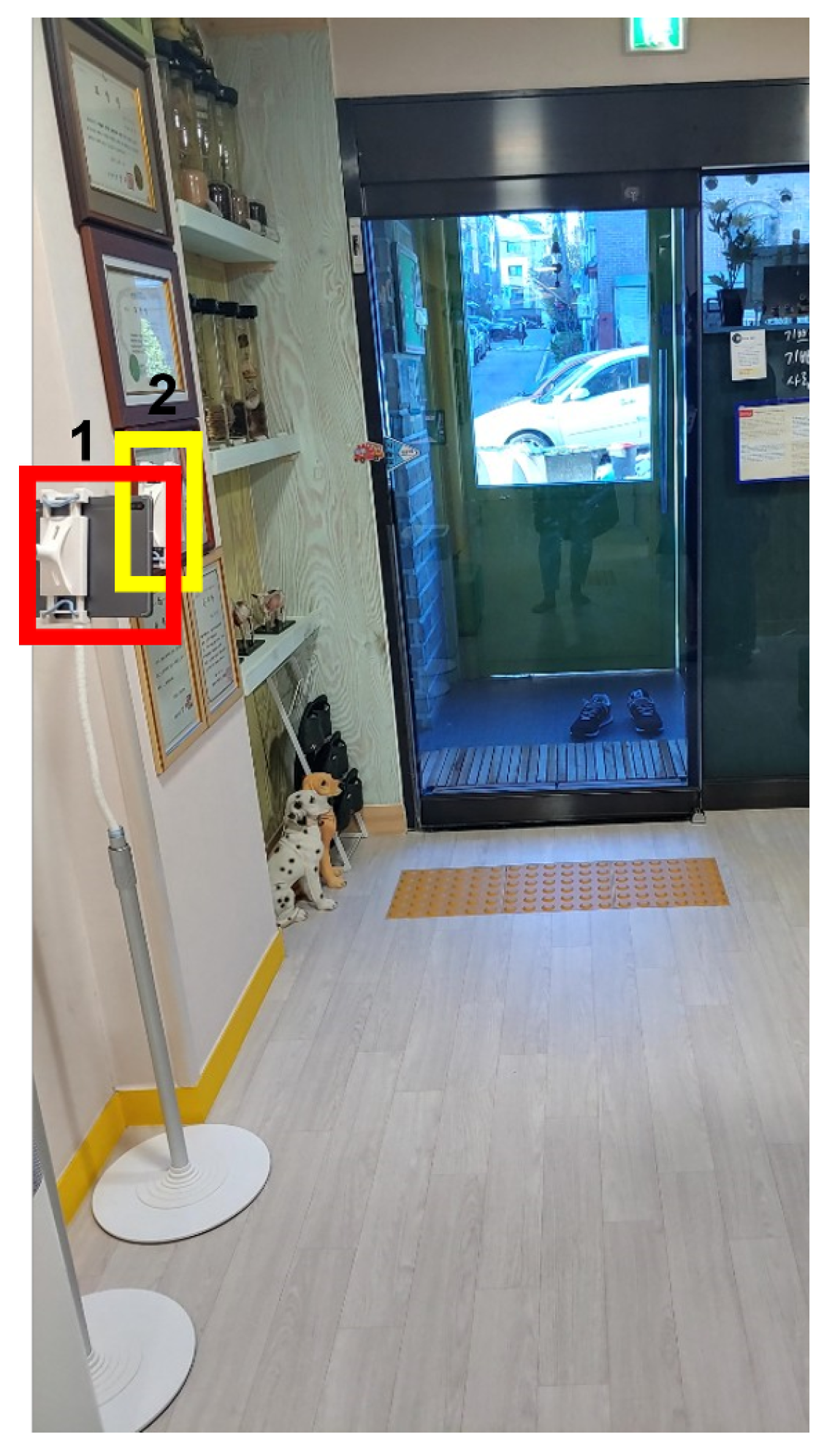
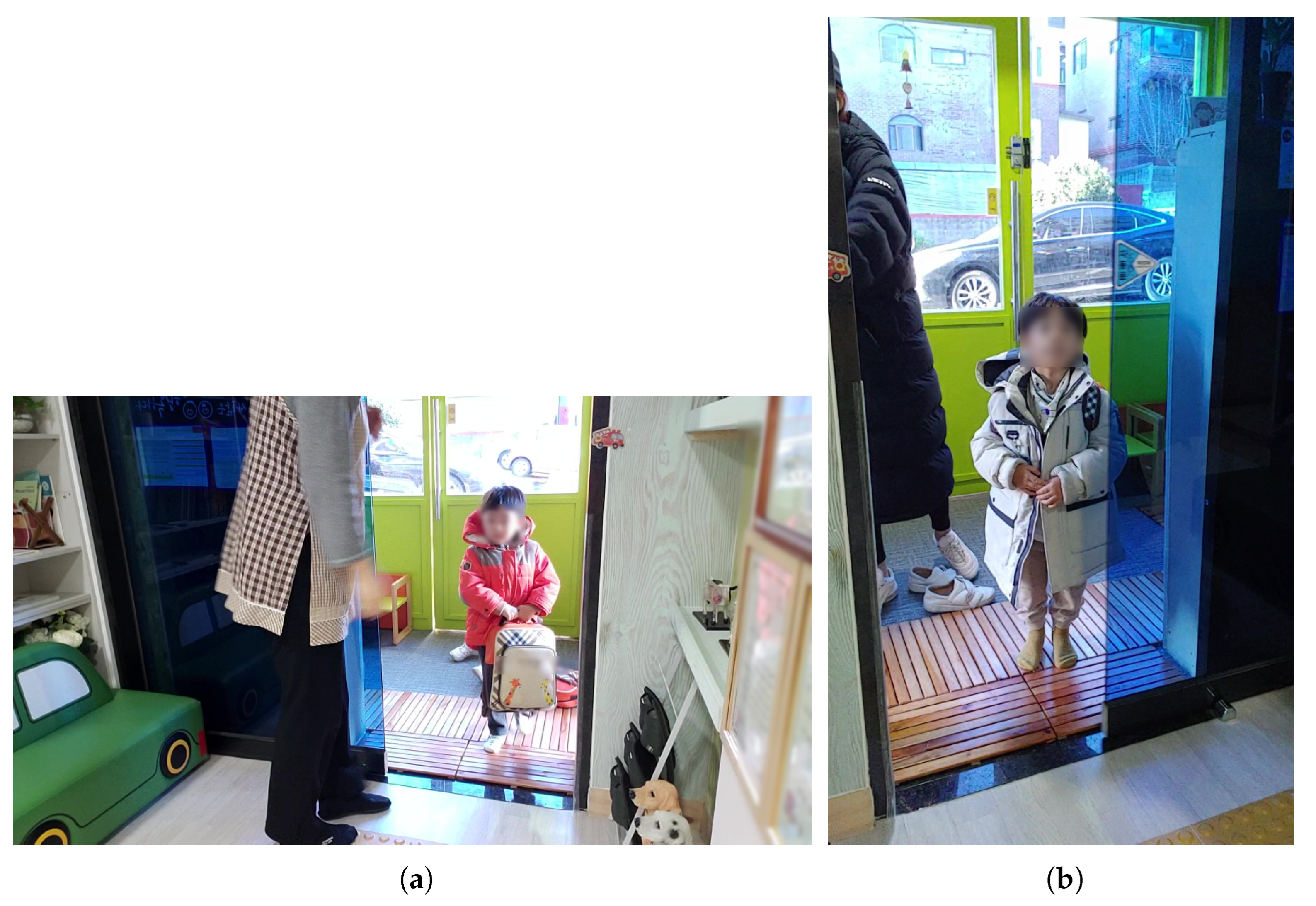
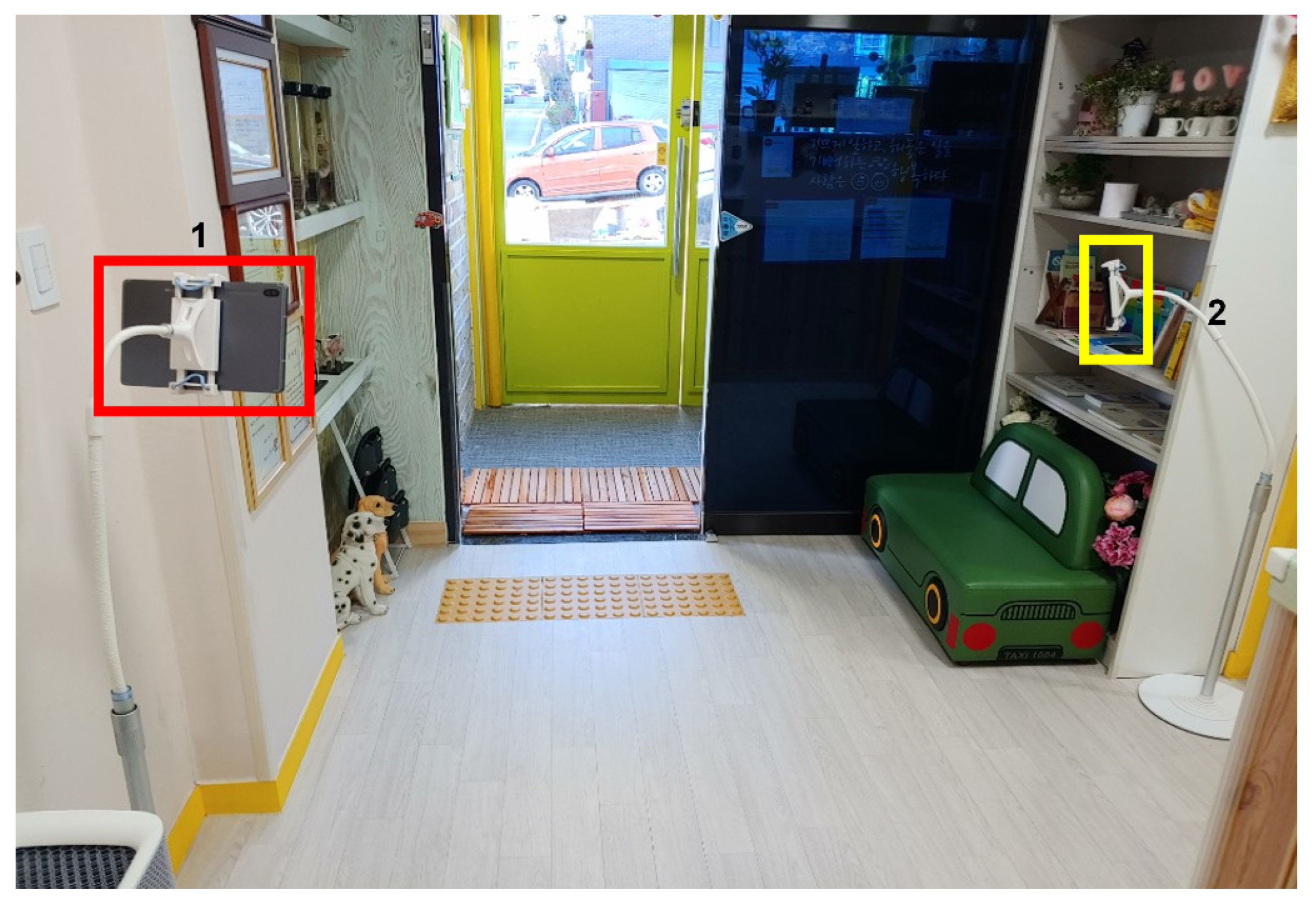
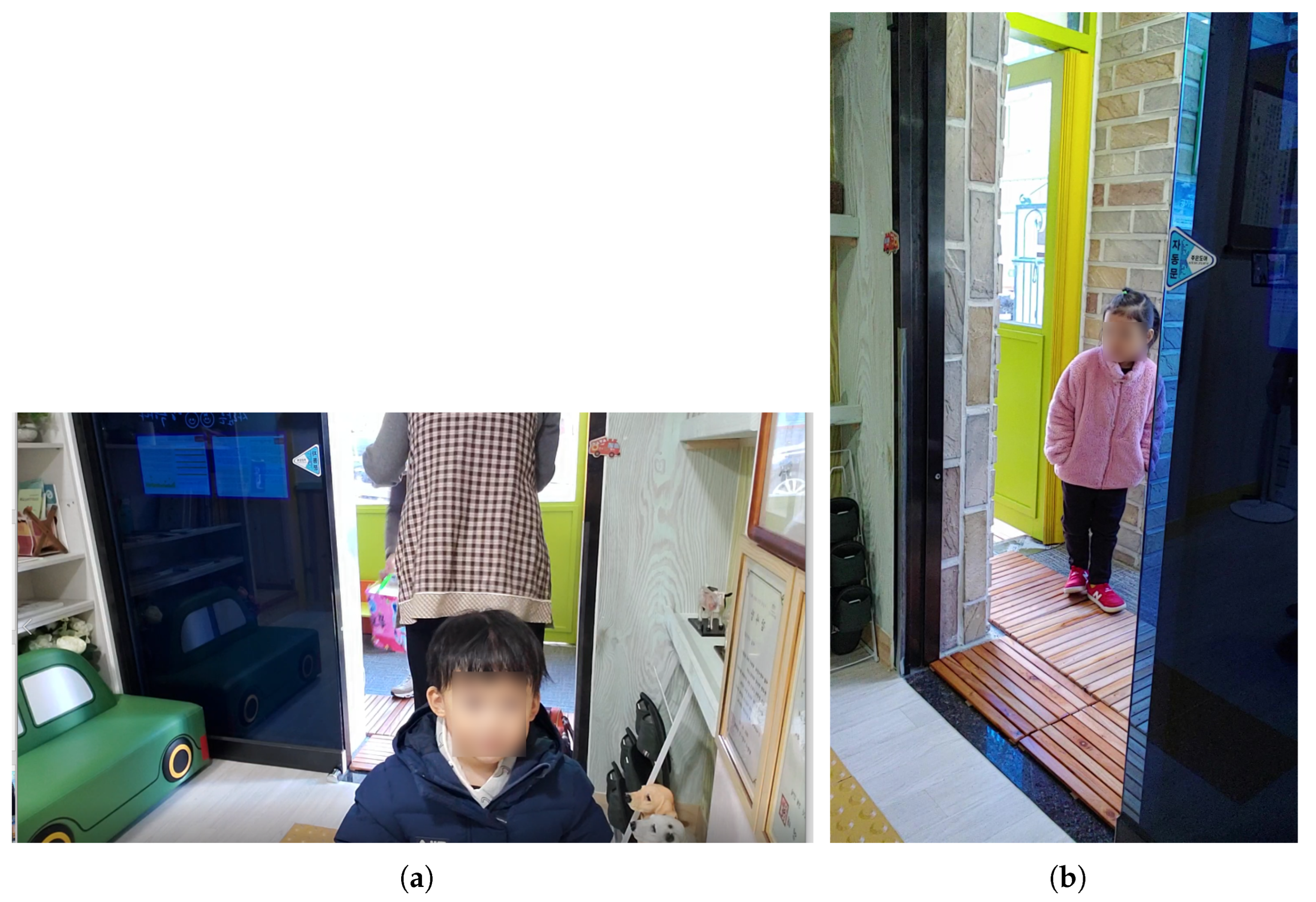
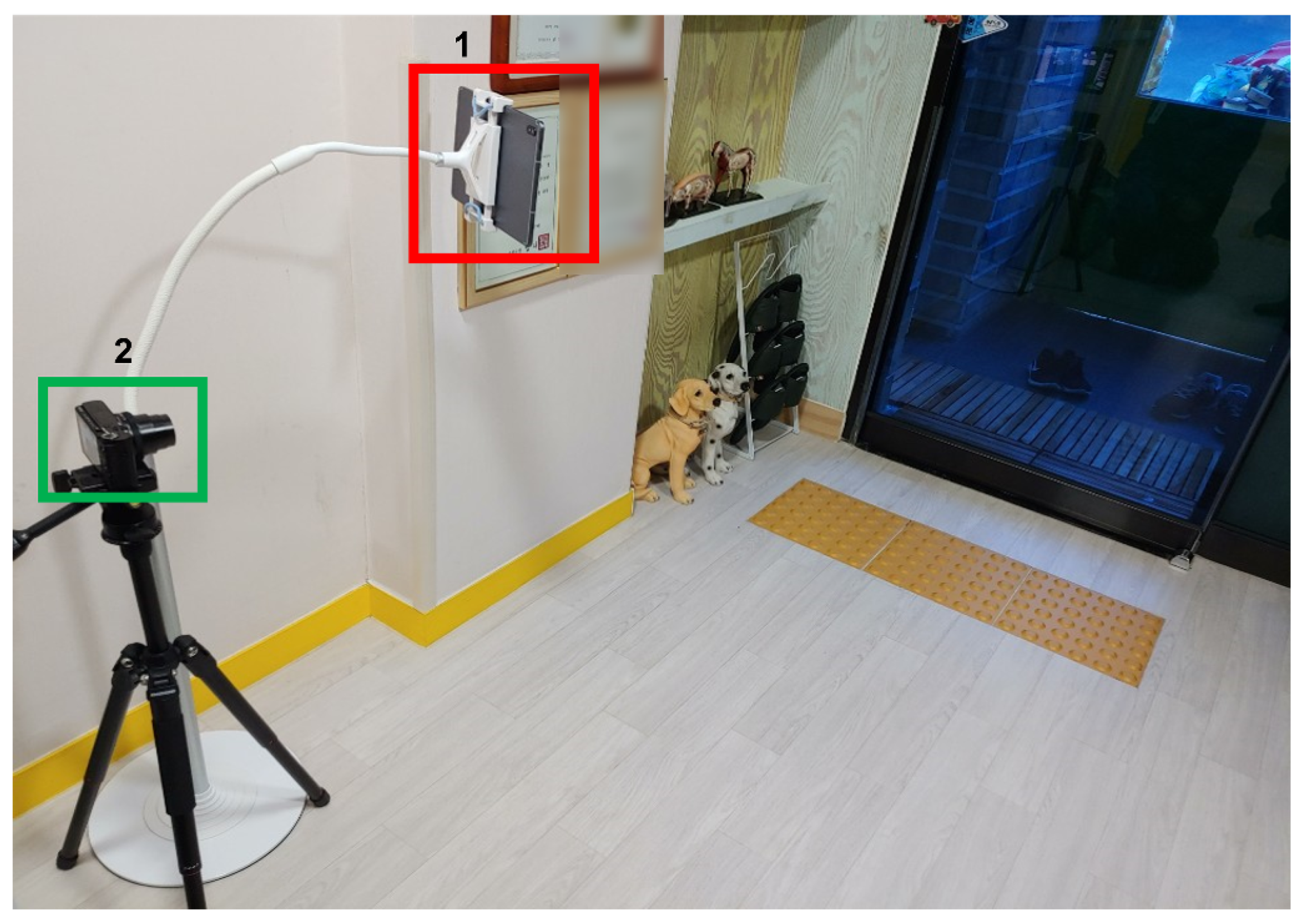

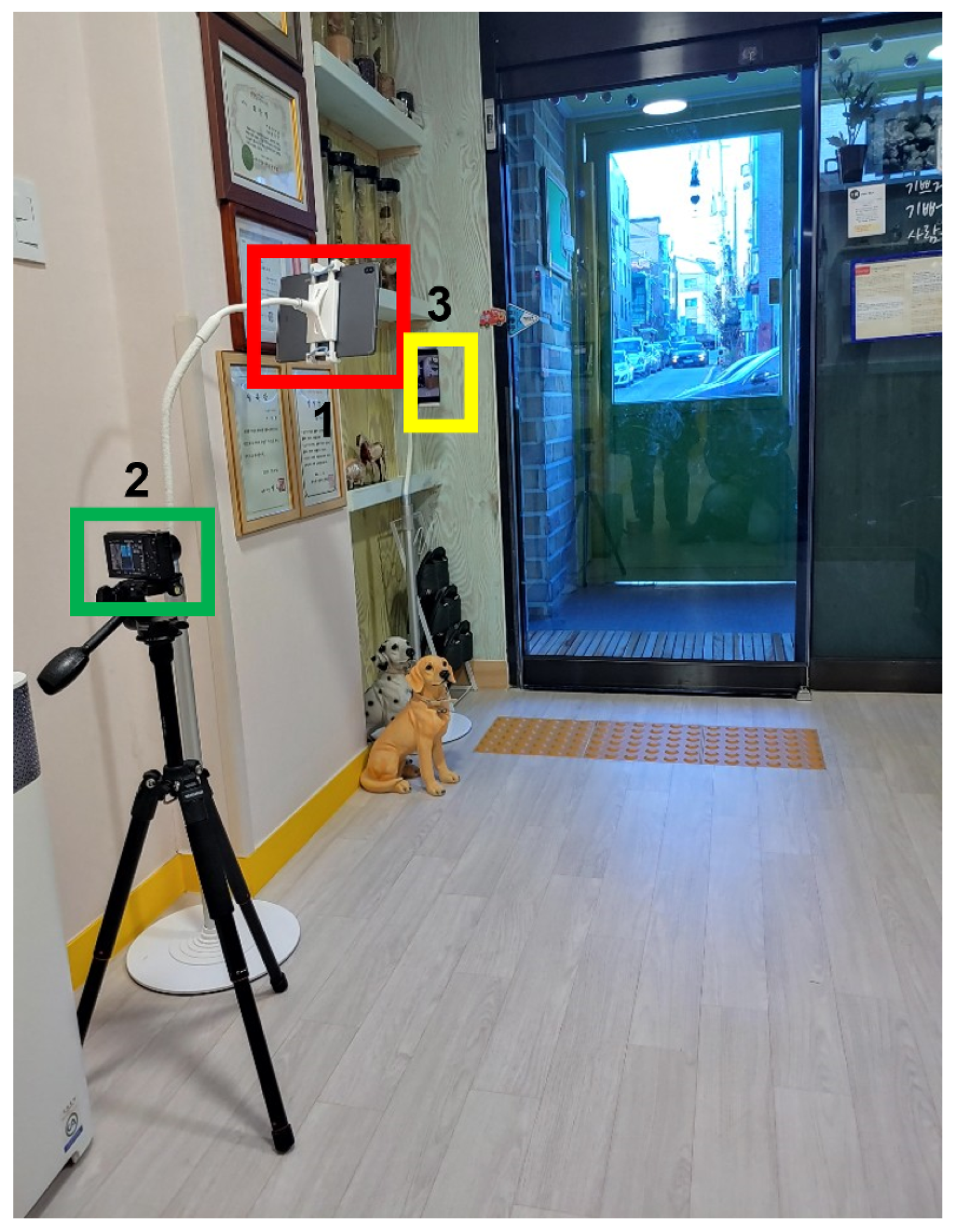
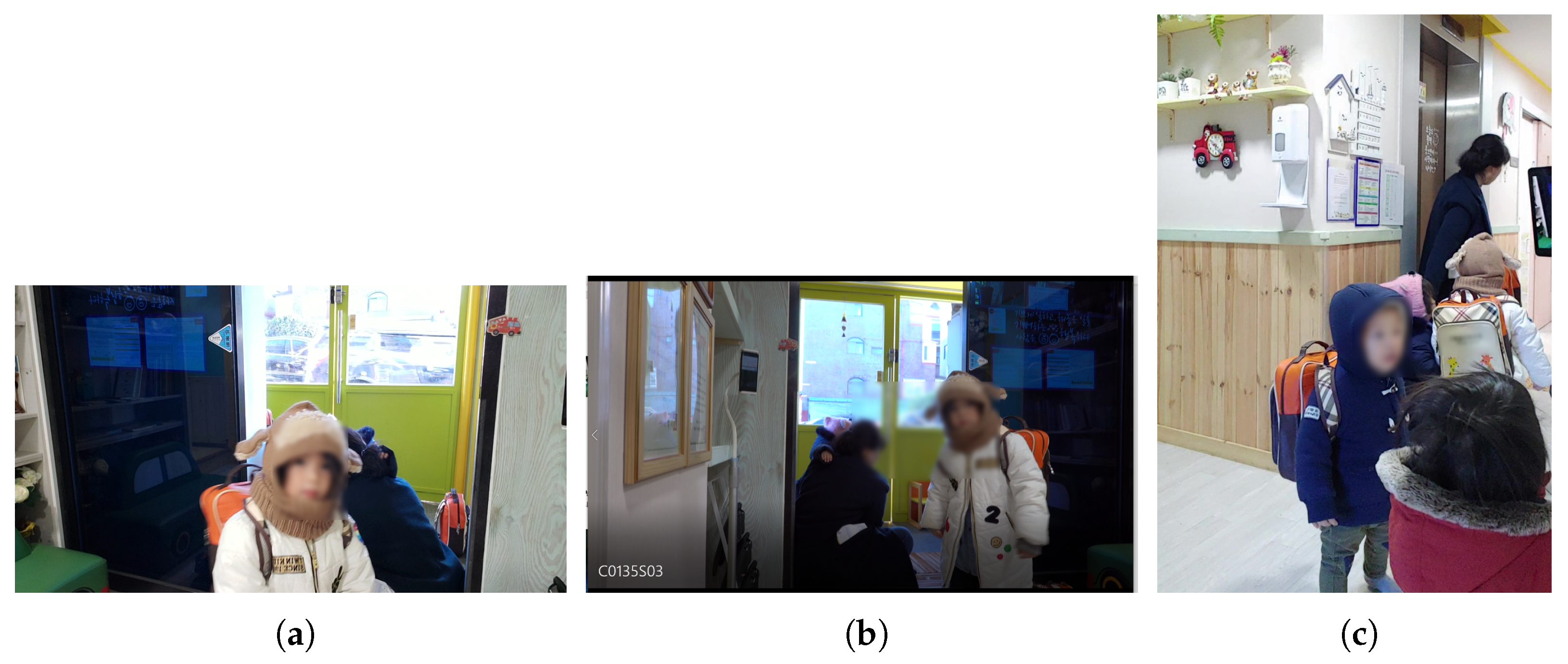
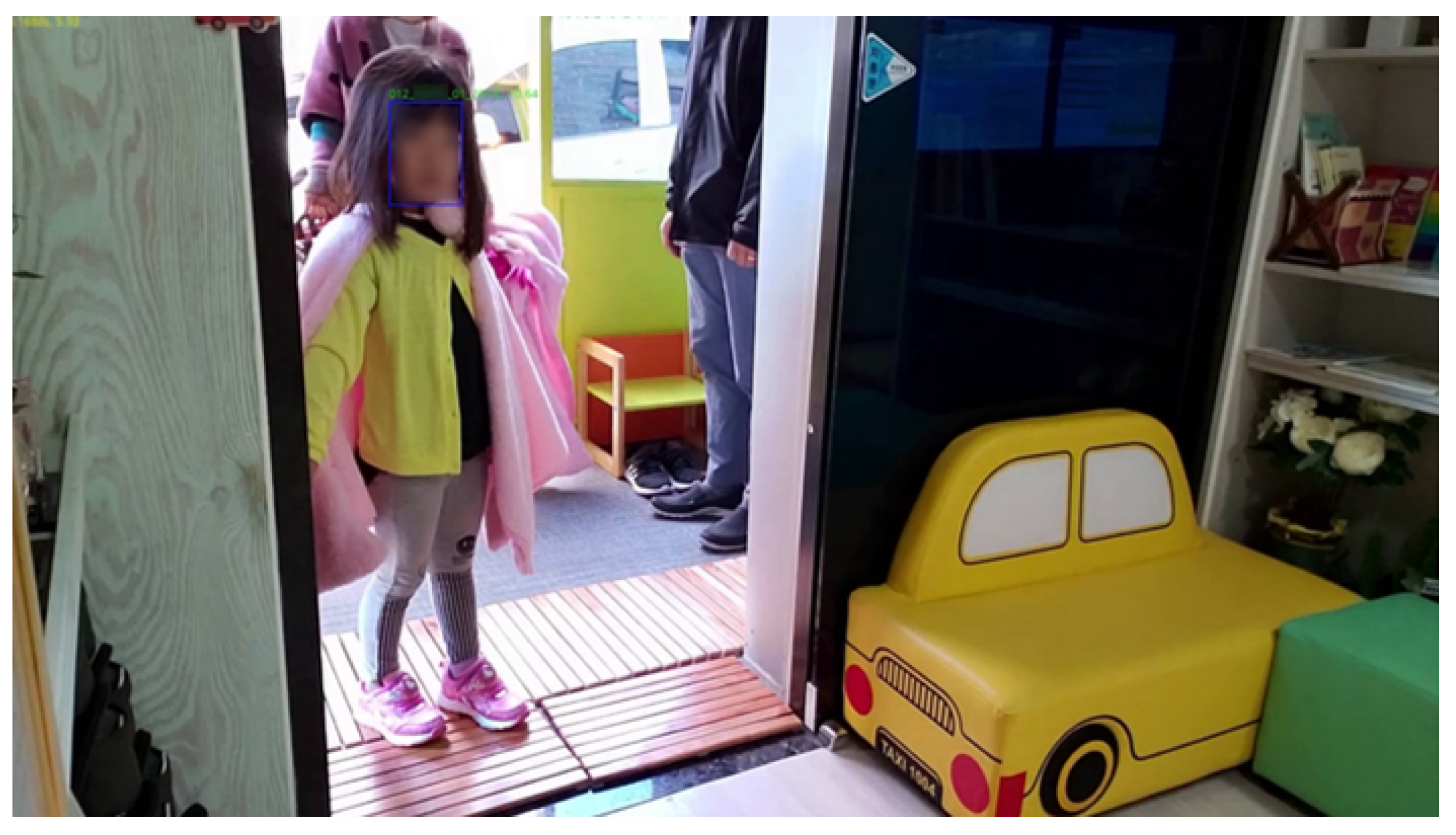
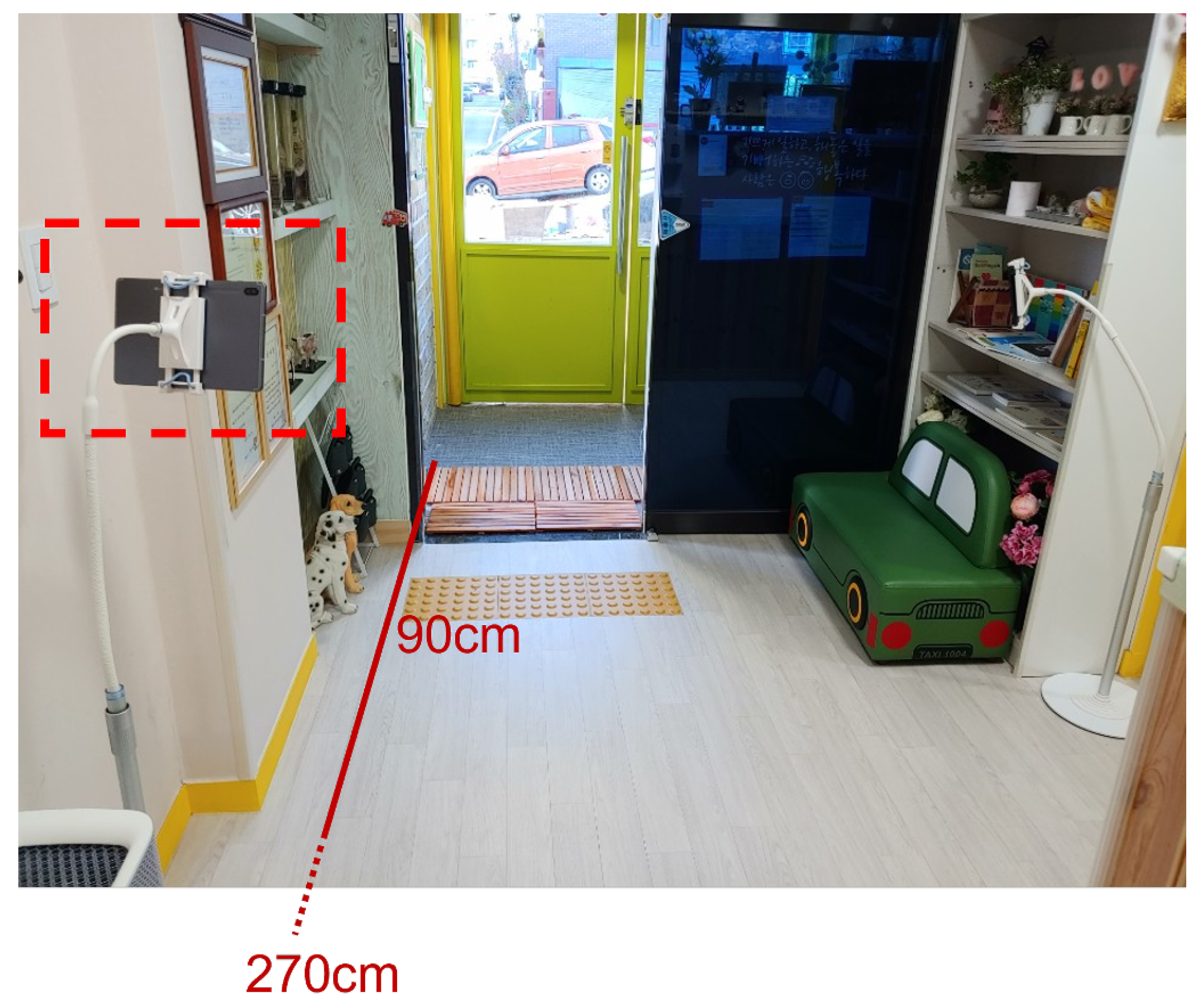
| Smart Phone: Rear Camera | Samsung Galaxy Wide 3 |
| Samsung Galaxy J3 2017 | |
| Tablet PC: Front Camera | Samsung Galaxy Tab S6 10.5 |
| Digital Camera | Sony Cyber-shot DSC-RX100 VII |
| Age | 7 | 6 | 5 | 4 | 3 | 2 | Total | |
|---|---|---|---|---|---|---|---|---|
| Gender | ||||||||
| Male | 4 | 4 | 14 | 7 | 7 | 2 | 38 | |
| Female | 4 | 6 | 8 | 14 | 3 | 1 | 36 | |
| Total | 8 | 10 | 22 | 21 | 10 | 3 | 74 | |
| Database Variable | Explanation |
|---|---|
| user_id | Unique ID for an child |
| face_embedding | Child face embedding data |
| update_date | Child face embedding data upload date |
| Location | Strengths | Weaknesses |
|---|---|---|
| Entrance Figure 4b |
|
|
| School bus traffic stop Figure 4c |
|
|
| Door Figure 4d |
|
|
| Indoor |
|
|
| Video Type | True | False | Not Detect | Total Frame |
|---|---|---|---|---|
| Far away | 16 | 36 | 48 | 100 |
| Closer near | 792 | 198 | 10 | 1000 |
| Algorithm | Number of Faces Detected/ Total Number of Faces (Ratio) | FPS |
|---|---|---|
| MTCNN | 139/194 (71.65%) | 21.09 |
| RetinaFace | 171/194 (88.14%) | 27.98 |
| Video index | 1 | 2 | 3 | 4 | 5 | 6 | 7 | 8 | 9 |
| The number of children | 1 | 1 | 5 | 4 | 5 | 1 | 1 | 2 | 7 |
| Length (min:s) | 1:00 | 1:05 | 2:55 | 1:44 | 1:10 | 0:40 | 1:21 | 1:35 | 2:19 |
| Video index | 10 | 11 | 12 | 13 | 14 | 15 | 16 | 17 | |
| The number of children | 1 | 1 | 11 | 1 | 3 | 2 | 1 | 1 | |
| Length (min:s) | 1:28 | 0:36 | 3:54 | 0:39 | 1:06 | 0:41 | 0:50 | 0:54 |
| Embedding Score | 0.1 | 0.2 | 0.3 | 0.4 | 0.5 | 0.6 | 0.7 | 0.8 | 0.9 | 1 | |
|---|---|---|---|---|---|---|---|---|---|---|---|
| Video Index | |||||||||||
| 1 | 70.18 | 70.18 | 70.18 | 70.18 | 70.18 | 68.98 | 63.55 | 59.04 | 53.92 | 37.95 | |
| 2 | 62.83 | 62.83 | 62.83 | 62.71 | 62.83 | 63.82 | 64.80 | 62.83 | 58.22 | 47.37 | |
| 3 | 54.68 | 54.68 | 54.68 | 55.49 | 61.88 | 71.87 | 77.88 | 71.44 | 66.22 | 60.66 | |
| 4 | 45.98 | 45.98 | 45.98 | 48.14 | 61.58 | 69.12 | 72.61 | 71.62 | 68.82 | 61.19 | |
| 5 | 76.97 | 76.97 | 76.97 | 76.88 | 76.62 | 76.18 | 74.17 | 66.02 | 52.63 | 35.38 | |
| 6 | 55.40 | 55.40 | 55.40 | 55.40 | 58.63 | 75.90 | 83.81 | 82.01 | 73.02 | 61.51 | |
| 7 | 51.79 | 51.79 | 51.79 | 51.79 | 52.37 | 63.85 | 75.75 | 82.5 | 78.48 | 71.16 | |
| 8 | 58.10 | 58.10 | 58.25 | 58.61 | 60.17 | 63.11 | 66.89 | 66.68 | 55.72 | 44.65 | |
| 9 | 69.83 | 69.83 | 69.83 | 69.68 | 70.48 | 74.66 | 79.94 | 81.00 | 75.27 | 62.92 | |
| 10 | 88.42 | 88.42 | 88.42 | 88.42 | 88.97 | 89.08 | 76.41 | 69.24 | 55.90 | 34.73 | |
| 11 | 67.37 | 67.37 | 67.37 | 67.37 | 70.06 | 80.54 | 85.03 | 91.62 | 91.02 | 78.44 | |
| 12 | 57.87 | 57.87 | 57.98 | 62.12 | 74.67 | 83.57 | 85.67 | 79.6 | 71.54 | 61.76 | |
| 13 | 85.30 | 85.30 | 85.30 | 85.30 | 86.20 | 88.91 | 89.18 | 89.81 | 83.59 | 63.30 | |
| 14 | 78.94 | 78.94 | 78.94 | 78.94 | 79.75 | 82.87 | 84.05 | 78.13 | 67.85 | 51.90 | |
| 15 | 81.72 | 81.72 | 81.72 | 81.72 | 82.14 | 83.16 | 79.26 | 73.10 | 66.74 | 59.75 | |
| 16 | 74.25 | 74.25 | 74.25 | 74.25 | 76.49 | 80.97 | 86.57 | 82.84 | 74.63 | 68.66 | |
| 17 | 100 | 100 | 100 | 100 | 100 | 100 | 100 | 100 | 100 | 100 | |
| Average | 62.09% | 62.09% | 62.1% | 62.47 | 64.9% | 69.29% | 70.82% | 68.81 | 62.82% | 52.70% | |
Publisher’s Note: MDPI stays neutral with regard to jurisdictional claims in published maps and institutional affiliations. |
© 2022 by the authors. Licensee MDPI, Basel, Switzerland. This article is an open access article distributed under the terms and conditions of the Creative Commons Attribution (CC BY) license (https://creativecommons.org/licenses/by/4.0/).
Share and Cite
Won, H.-m.; Lee, H.; Song, G.; Kim, Y.; Kwak, N. Reliable Data Collection Methodology for Face Recognition in Preschool Children. Sensors 2022, 22, 5842. https://doi.org/10.3390/s22155842
Won H-m, Lee H, Song G, Kim Y, Kwak N. Reliable Data Collection Methodology for Face Recognition in Preschool Children. Sensors. 2022; 22(15):5842. https://doi.org/10.3390/s22155842
Chicago/Turabian StyleWon, Hye-min, Hyeogjin Lee, Gyuwon Song, Yeonghun Kim, and Nojun Kwak. 2022. "Reliable Data Collection Methodology for Face Recognition in Preschool Children" Sensors 22, no. 15: 5842. https://doi.org/10.3390/s22155842
APA StyleWon, H.-m., Lee, H., Song, G., Kim, Y., & Kwak, N. (2022). Reliable Data Collection Methodology for Face Recognition in Preschool Children. Sensors, 22(15), 5842. https://doi.org/10.3390/s22155842






